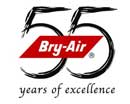|
|
| |
| Humidity Control / Moisture Removal with Bry-Air Dehumidifiers |
|
Relative humidity in occupied space should be maintained between 30% - 60% to minimize growth of allergenic or pathogenic organisms. Excessive humidity can damage building also. Also, Relative humidity in ductwork should not exceed 70% RH to prevent fungal contamination (Mold, Mildew, etc.). |
| Desiccant Dehumidification – for Dry, Healthy Facility |
| Desiccant systems remove moisture in a vapour phase. The air is not saturated as it enters the ductwork, so the supply ductwork is dry. The dry air prevents fungus and bacteria from growing in coils, ducts and drain pans. |
The use of desiccant dehumidifiers thus becomes the preferred alternative as it provides: |
| » |
Lower Relative Humidity than conventional approach |
| » |
Reduced conventional cooling tonnage requirement |
| » |
Independent control of temperature/humidity |
| » |
Lower energy costs |
|
The ideal solution is to use desiccant dehumidification in conjunction with energy recovery |
| Read more... |
| |
| Dehumidifiers on Rental for Short Term Humidity Control needs for Hospitality |
|
Concrete Drying, also known as curing, requires the moisture content of concrete to be around 3-5%. Our dehumidifiers speed up the concrete drying process for a faster project completion time. Seasonal high humidity and inadequate drying results reduced coating life and longer project completion time. Dehumidifiers can provide continuous hot dry air to dry concrete/pop faster and maintain recommended conditions irrespective of ambient humidity level and temperature.
TDS also provide moisture removal and drying services for Water Damage Restoration. Firefighting activities, damaged pipes, natural disaster, human error, leakages etc. can cause immense loss to commercial establishments. You can reduce replacement costs and minimize business interruption by hiring our moisture removal services to restore damaged furniture, electronic equipment, carpets, storage devices, art, library, archives, electromechanical equipment etc. |
| Read more... |
| |
| IAQ, Odour Control & Energy Recovery, Dry Energy Wheels, Treated Fresh Air |
|
The quality of indoor environmental has an impact on guest comfort, and their perception of quality. The amount of time they spend inside is also governed by the fact whether they are being given all round comfort including a fresh feeling inside the air-conditioned space.
Conditioned indoor air, more often contains all of the pollutants of the pollutants generated by occupants and their activities. This is because the conditioned spaces are of “closed” types, with no or low fresh air provision, to keep the energy bills down. The result is, that the stale air containing germs and pollutants is re-circulated again and again giving rise to feelings of stuffiness, dizziness, nausea, lethargy and fatigue, affecting comfort, concentration and performance. All these are indicators of serious Indoor Air Quality (IAQ) problems.
Sources of poor IAQ in hospitality facilities range from incorrectly designed air conditioned resulting in inadequate air ventilation, high humidity, musty odours, fumes of cleaning agents and from computers, photocopiers, thick carpets, VOCs, tobacco smoke, steaming hot food, etc.
The EcoFresh Energy Recovery Wheel, which recovers total energy (sensible as well as latent), assists in meeting all the requirements of Indoor Air Quality (IAQ), humidity control and energy saving.
Incorporation of EcoFresh Heat Wheels into the air-conditioning system means more outdoor air at lower energy cost (reduced chiller load).
DRI Energy Recovery Ventilators are equipped with EcoFresh Energy Recovery Wheels (ERW); capable of recovering more than upto 75% of each sensible and latent energy from the stale exhaust air and transferring it to the fresh outside air. The rotating wheel transfers the sensible and latent energy between the counter flowing exhaust and supply air and in the process preconditions (cool/ heat/ dehumidify/ humidify) the fresh air |
| Read more... |
| |
|
| |
| |
|







